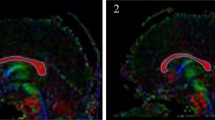Abstract
It is traditionally believed that edema associated with brain contusion is vasogenic. The objective of this study was to quantify and characterize the edema in cortical contusion coupled with early hypoxia and hypotension.
Sprague-Dawley rats were randomised into six groups: Sham, Trauma moderate (Tm), Trauma severe (Ts), Hypoxia and Hypotension (HH), Tm and Ts with HH (THHm; THHs). Trauma was induced with controlled cortical impact; associated secondary insults lasted 30 minutes. Water content was measured using tissue longitudinal relaxation time (T1). Apparent diffusion coefficient of water (ADC) was calculated from diffusion-weighted imaging and single voxel spectroscopy.
In the trauma groups ICP increased at 30 minutes post trauma (p < 0.05) and then gradually decreased. Only in the THH groups, ICP showed a trend to continually rise. No ICP variations were seen in the others groups. The increase in water content at 4 hours post trauma was inversely related to ADC variation (p < 0.0001). A significant increase in water content with low ADC, developed in the injured region in Ts, THHm (p < 0.05) and THHs (p < 0.01) compared to Sham. Intracellular water rose in the whole brain in THH groups although more severely in the THHs (p < 0.01). Immediately after trauma ADC fell in the THH groups, but gradually increased in the THHm, whereas there was no recovery in THHs.
The results indicate that the type of edema in the injured area, with and without superimposed secondary insult, is predominantly cytotoxic (cellular). Moreover, secondary insults act synergistically with focal injury to increase cellular water in both injured tissue and remote regions.
Access this chapter
Tax calculation will be finalised at checkout
Purchases are for personal use only
Similar content being viewed by others
References
Chesnut RM, Marshall LF, Klauber MR et al (1993) The role of secondary brain injury in determining outcome from severe head injury. J Trauma 34: 216–222
Dixon CE, Clifton GL, Lighthall JW, Yaghnai AA, Hayes RL (1991) A controlled cortical impact model of traumatic brain injury in the rat. Neurosci Meth 39: 253–261
Fatouros PP, Marmarou A, Kraft KA, Inao S, Schwarz FP (1991) In vivo brain water determination by T1 measurements: effect of total water content, hydratation fraction and field strenght. Magnetic Resonance Med 17: 402–413
Ito J, Marmarou A, Barzo P, Fatouros P, Corwin F (1996) Characterization of edema by diffusion-weighted imaging in experimental traumatic brain injury. J Neurosurg 84: 97–103
Ebisu T, Naruse S, Horikawa et al (1993) Discrimination between different types of white matter edema with diffusion-weighted MR imaging. JMRI 3: 863–868
Miller JD, Butterworth JF, Gudeman SK et al (1981) Further experience in the management of severe head injury. J Neurosurg 54: 289–299
Stroop R, Thomale UW, Pauser S et al (1998) Magnetic resonance imaging studies with cluster algorithm for characterization of brain edema after Controlled Cortical Impact Injury (CCII). Acta Neurochir [Suppl] (Wien) 71: 303–305
Stocchetti N, Furlan A, Volta F (1996) Hypoxemia and arterial hypotension at the accident scene in head injury. J Trauma 40: 1–4
Author information
Authors and Affiliations
Editor information
Editors and Affiliations
Rights and permissions
Copyright information
© 2000 Springer-Verlag Wien
About this paper
Cite this paper
Portella, G., Beaumont, A., Corwin, F., Fatouros, P., Marmarou, A. (2000). Characterizing Edema Associated with Cortical Contusion and Secondary Insult Using Magnetic Resonance Spectroscopy. In: Mendelow, A.D., et al. Brain Edema XI. Acta Neurochirurgica Supplements, vol 76. Springer, Vienna. https://doi.org/10.1007/978-3-7091-6346-7_56
Download citation
DOI: https://doi.org/10.1007/978-3-7091-6346-7_56
Publisher Name: Springer, Vienna
Print ISBN: 978-3-7091-7257-5
Online ISBN: 978-3-7091-6346-7
eBook Packages: Springer Book Archive




